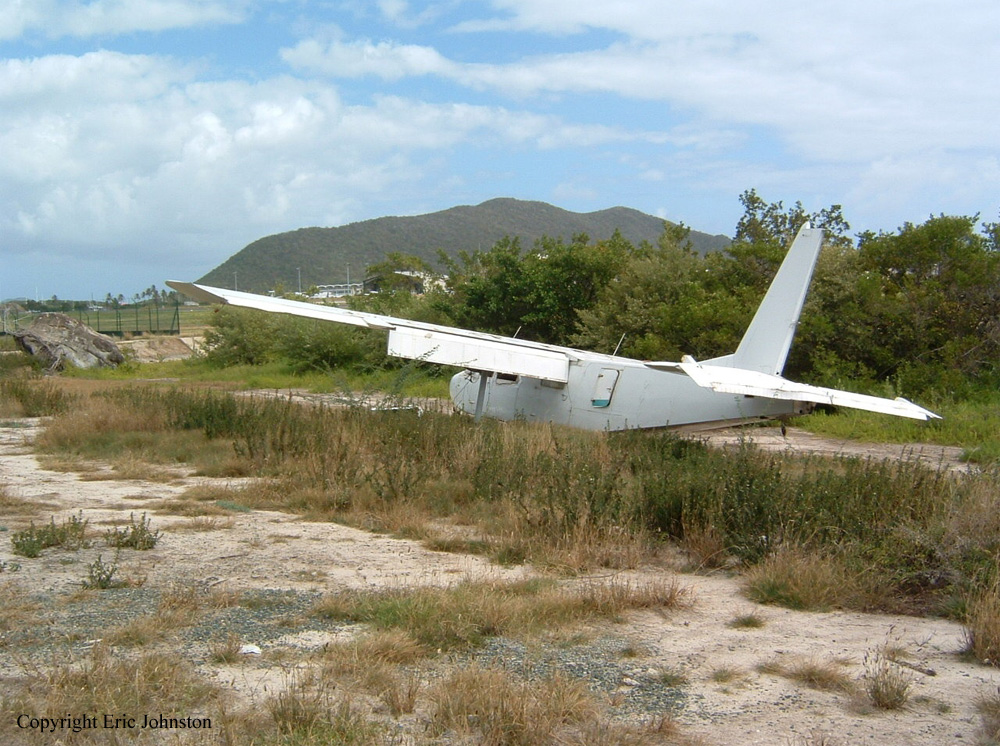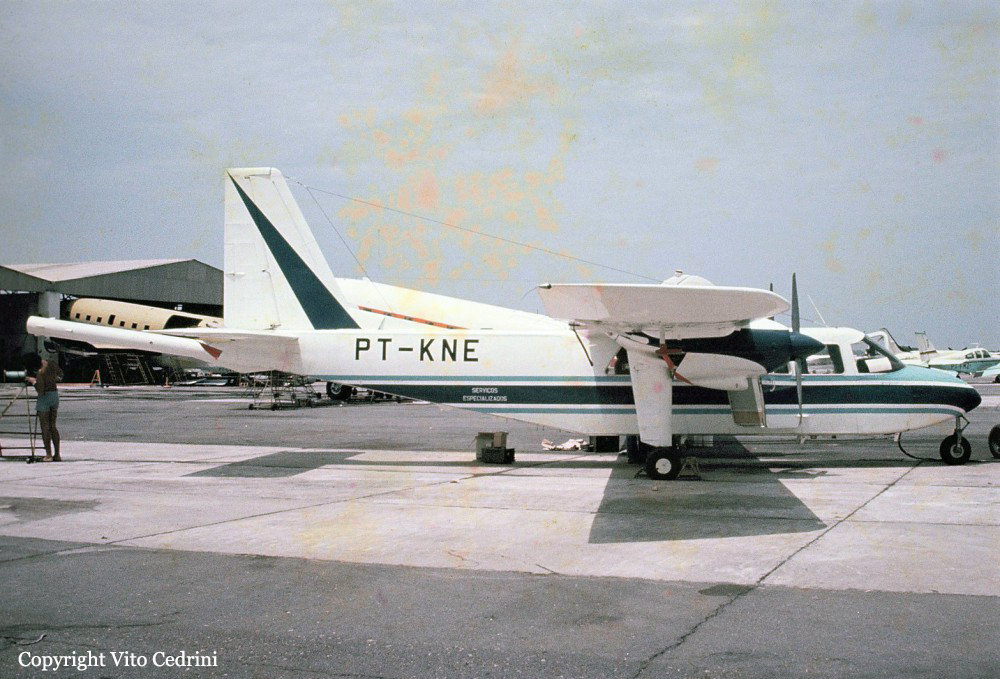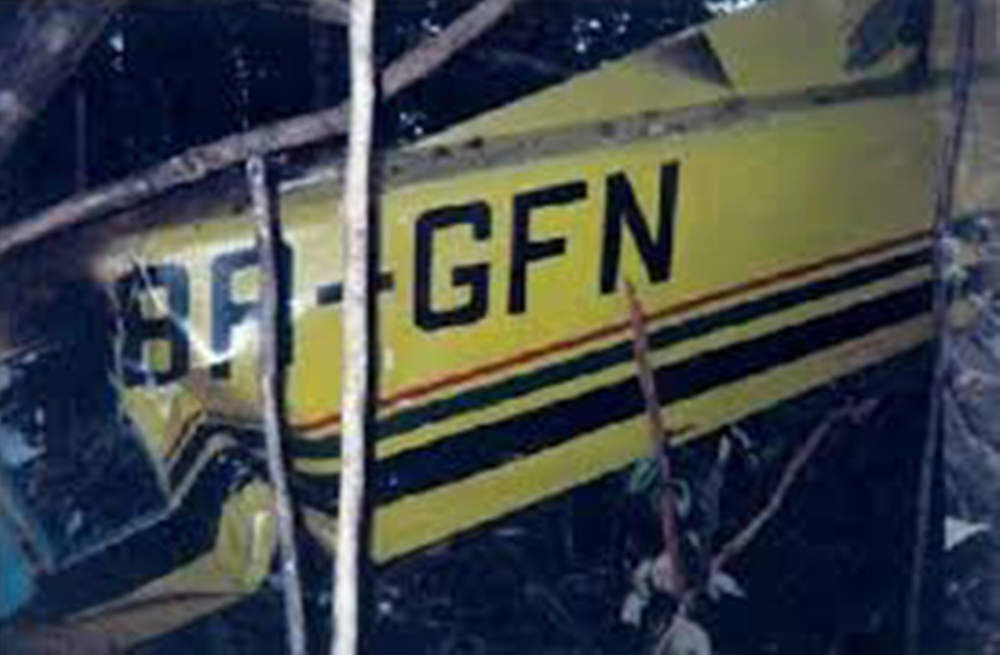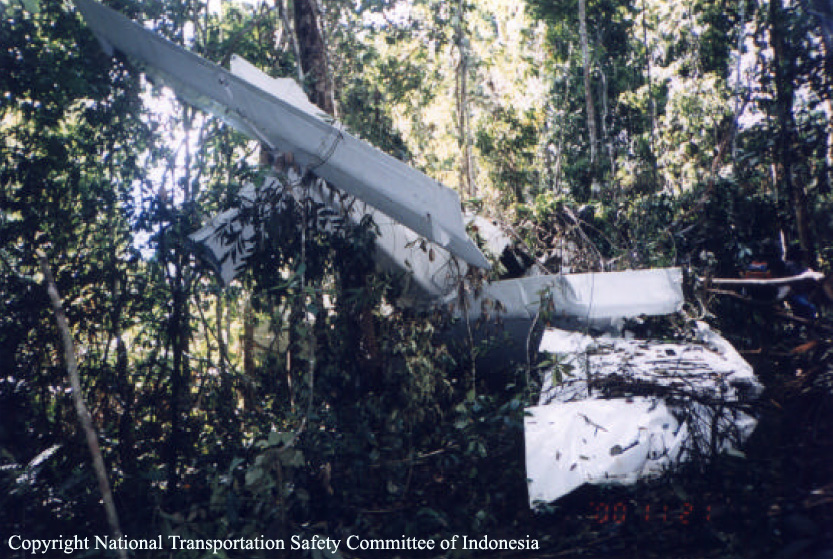Country
Crash of a Britten-Norman BN-2A-27 Islander off Beef Island
Date & Time:
Jan 18, 2002 at 1440 LT
Registration:
N616GL
Survivors:
Yes
Schedule:
Tortola - Tortola
MSN:
616
YOM:
1970
Crew on board:
1
Crew fatalities:
Pax on board:
3
Pax fatalities:
Other fatalities:
Total fatalities:
0
Circumstances:
On January 18, 2002 at 1440 eastern standard time, a Britten-Norman BN2-A, N616GL, operated by Fly BVI Inc,. under the provision Title 14 CFR Part 135, as a sightseeing flight, ditched off Beef Island, British Virgin Islands, following a loss of engine power on both engines. Visual meteorological conditions prevailed and no flight plan was filed. The airplane was substantially damaged. The air transport pilot and his passengers were not injured. The flight departed Beef Island, British Virgin Islands, at 1400. According to the pilot, during a sightseeing tour the airplane experience a total loss of power on both engines at the same time. The pilot contacted the Beef Island control tower and declared an emergency and gave his position report. He then stated his intentions to ditch the airplane off the coast of Beef Island, British Virgin Islands. The airplane came to rest in six feet of water near the shoreline. During the examination of the airplane by personnel from the Department of Civil Aviation, British Virgin Islands, approximately 23 gallons of fuel were discovered in each fuel tank.

Crash of a Britten-Norman BN-2B-26 Islander in Bremerhaven: 8 killed
Date & Time:
Dec 26, 2001 at 1013 LT
Registration:
D-IAAI
Survivors:
Yes
Schedule:
Bremerhaven - Wangerooge
MSN:
2167
YOM:
1985
Crew on board:
1
Crew fatalities:
Pax on board:
8
Pax fatalities:
Other fatalities:
Total fatalities:
8
Circumstances:
The departure from Bremerhaven to the Wangerooge Island was delayed for 30 minutes due to snow showers over the airport. Prior to departure, the pilot manually removed snow from the windshield, leading edge and wings. After takeoff from runway 34, the twin engine aircraft climbed slowly to a height of about 195 feet then stalled and crashed in the Weser River. The crew of a ferry was quickly on the scene to rescue a passenger while eight other occupants were killed.
Probable cause:
It was determined that the snow over the wings was not properly removed prior to takeoff, causing a loss of lift and disturbing the airflow. There were no defined procedures about deicing in the Standard Operating Procedures (SOP) manual of the operator.

Crash of a Britten-Norman BN-2A-27 in Bujari
Date & Time:
Sep 22, 2001 at 1207 LT
Registration:
PT-KTQ
Survivors:
Yes
Schedule:
Rio Branco - Rio Branco
MSN:
493
YOM:
1976
Crew on board:
1
Crew fatalities:
Pax on board:
4
Pax fatalities:
Other fatalities:
Total fatalities:
0
Captain / Total hours on type:
300.00
Circumstances:
The twin engine aircraft departed Rio Branco with four passengers and one pilot on board. The goal of the flight was to carry four Japanese journalists who wanted to perform aerial views from various tribes located in the region of Santa Rosa do Purus. About 30 minutes into the flight, an oil leak occurred on the left engine that lost power. The pilot reduced his altitude and attempted an emergency landing when the aircraft crashed near Bujari, about 39 km from Rio Branco. The wreckage was found near motorway BR364 and all five occupants were slightly injured.
Probable cause:
The following findings were identified:
- It is likely that the pilot did not use the controls properly to maintain an adequate control of the airplane in a single-engine configuration while the airplane was operated within weight and balance limits,
- The left propeller retainer had been replaced by similar but not original equipment, using glue to ensure its tightness, which was non compliant with the engine manufacturer's procedures,
- The aircraft maintenance documents were not kept up to date by the operator,
- Poor flight preparation on the part of the pilot who did not notice that the maintenance documents were not up to date,
- The operator was not compliant with the current Brazilian Civil Aviation Authority legislation.
- It is likely that the pilot did not use the controls properly to maintain an adequate control of the airplane in a single-engine configuration while the airplane was operated within weight and balance limits,
- The left propeller retainer had been replaced by similar but not original equipment, using glue to ensure its tightness, which was non compliant with the engine manufacturer's procedures,
- The aircraft maintenance documents were not kept up to date by the operator,
- Poor flight preparation on the part of the pilot who did not notice that the maintenance documents were not up to date,
- The operator was not compliant with the current Brazilian Civil Aviation Authority legislation.
Final Report:
Crash of a Britten-Norman BN-2A-21 Islander near Cascalho: 3 killed
Date & Time:
Jan 11, 2001 at 1440 LT
Registration:
PT-KNE
Survivors:
No
Schedule:
Paramirim - Paramirim
MSN:
696
YOM:
1973
Crew on board:
2
Crew fatalities:
Pax on board:
1
Pax fatalities:
Other fatalities:
Total fatalities:
3
Captain / Total hours on type:
3263.00
Copilot / Total hours on type:
23
Circumstances:
The twin engine aircraft departed Paramirim Airport at 1400LT on a 3-hours ore prospecting flight, carrying two pilots and one passenger. En route, weather conditions worsened and the crew apparently decided to return to Paramerim when he encountered atmospheric turbulences and windshear. The aircraft stalled and crashed in a mountainous area. After 17 hours without contact, the aircraft was declared as missing. Its wreckage was found the following day at 1800LT near the summit of Mt Serra Preta, near Cascalho, about 27 km east of Paramirim. The aircraft was destroyed and all three occupants were killed.
Probable cause:
Loss of control after the crew encountered adverse weather conditions with low level windshear. The following contributing factors were identified:
- Although the operations were carried out in accordance with the regulations in force, the pilots regularly exceeded the flight times and this type of prospecting mission is extremely tiring insofar as it is systematically operated at low altitude without the aid of the autopilot system in a high outside temperature environment, leading to greater than normal physical wear of the pilots,
- Poor flight preparation regarding the probable evolution of the weather conditions,
- The accident occurred in low visibility as the crew was presumably trying to return to his base,
- The accident occurred outside of the intended flight area,
- The flight, which was scheduled to take three hours, was started with an aircraft whose tanks were full (seven hours autonomy), unnecessarily increasing its weight,
- Poor flight planning,
- Non-compliance with standard operator procedures on part of the crew who positioned the flaps in an inappropriate angle to fly over obstacles,
- In the days preceding the accident, two incidents occurred at Paramirim Airport involving the captain, and neither of these two events had been reported to the management of the operator, indicating the absence of an effective control of operations,
- The supervision of crew schedules was poor,
- The operator wanted this type of flight to be carried out in the morning in order to avoid atmospheric turbulence specific to the region, but the crew decided to take off in the afternoon when the conditions were not favorable.
- Although the operations were carried out in accordance with the regulations in force, the pilots regularly exceeded the flight times and this type of prospecting mission is extremely tiring insofar as it is systematically operated at low altitude without the aid of the autopilot system in a high outside temperature environment, leading to greater than normal physical wear of the pilots,
- Poor flight preparation regarding the probable evolution of the weather conditions,
- The accident occurred in low visibility as the crew was presumably trying to return to his base,
- The accident occurred outside of the intended flight area,
- The flight, which was scheduled to take three hours, was started with an aircraft whose tanks were full (seven hours autonomy), unnecessarily increasing its weight,
- Poor flight planning,
- Non-compliance with standard operator procedures on part of the crew who positioned the flaps in an inappropriate angle to fly over obstacles,
- In the days preceding the accident, two incidents occurred at Paramirim Airport involving the captain, and neither of these two events had been reported to the management of the operator, indicating the absence of an effective control of operations,
- The supervision of crew schedules was poor,
- The operator wanted this type of flight to be carried out in the morning in order to avoid atmospheric turbulence specific to the region, but the crew decided to take off in the afternoon when the conditions were not favorable.
Final Report:

Crash of a Britten-Norman BN-2A-2 Islander in Mahdia: 3 killed
Date & Time:
Jan 6, 2001
Registration:
8R-GFN
Survivors:
No
Schedule:
Kato - Mahdia
MSN:
289
YOM:
1971
Crew on board:
2
Crew fatalities:
Pax on board:
1
Pax fatalities:
Other fatalities:
Total fatalities:
3
Circumstances:
The aircraft was completing a flight from Kato to Mahdia, carrying two pilots and one passenger on behalf of a public work company. On approach, the crew encountered marginal weather conditions when the twin engine aircraft struck the slope of Mt Ebini located 9 km short of runway and crashed in a wooded area. All three occupants were killed.

Crash of a Britten-Norman BN-2B-21 Islander in Datah Dawai
Date & Time:
Nov 18, 2000 at 1053 LT
Registration:
PK-VIY
Survivors:
Yes
Schedule:
Datah Dawai - Samarinda
MSN:
2133
YOM:
1981
Flight number:
AW3130
Crew on board:
1
Crew fatalities:
Pax on board:
17
Pax fatalities:
Other fatalities:
Total fatalities:
0
Captain / Total hours on type:
3632.00
Aircraft flight hours:
21336
Aircraft flight cycles:
20374
Circumstances:
The aircraft departed from Datah Dawai Airport for a regular commercial flight with destination airport, Samarinda, East Kalimantan. There were 18 persons on board including the pilot. Minutes after airborne, the aircraft crashed at a location of about 2 km north of the runway 02 extension. The pilot and 11 passengers were found seriously injured, while six sustained minor injuries or none. Weather was reported clear at the time of the occurrence.
Probable cause:
The following findings were identified:
- There are no signs of engine failure prior to the impact,
- The aircraft exceeded its manufacturer's MTOW on the flight from Datah Dawai to Samarinda,
- The aircraft center of gravity is near the aft limit of the CG flight envelope,
- The PIC apparently has a wrong perception on takeoff procedure. He thought that the optimum takeoff performance could be achieved by taking-off with a higher velocity. Meanwhile, in achieving high velocity one has to roll closer to the obstacle, which forced the aircraft to maintain a higher rate of climb,
- The PIC and Datah Dawai ground crews have endangered his passengers by letting more passengers loaded into the aircraft than the number of seats available,
- The PIC and Datah Dawai ground crews have endangered their passengers by improperly calculating the weight of aircraft payload,
- The operator did not have proper supervision system that may prevent such practice to happen,
- The operator has never filled out Flight Clearance, for its Samarinda - Datah Dawai operation,
- There are a lot more passengers or demand than the capacity of the Pioneer Flight Samarinda - Datah Dawai,
- There are not enough flight operation documents published (such as visual track and single engine emergency return guidance) to fly safely in and out of Datah Dawai,
- The exceeding MTOW, small stability margin, PIC takeoff habit, and lack of published safety documents for the area are the contributing factors to the accident.
There were found indications of practices that fit into the category of negligence, willful misconduct and violations of existing flight safety rules and regulations.
- There are no signs of engine failure prior to the impact,
- The aircraft exceeded its manufacturer's MTOW on the flight from Datah Dawai to Samarinda,
- The aircraft center of gravity is near the aft limit of the CG flight envelope,
- The PIC apparently has a wrong perception on takeoff procedure. He thought that the optimum takeoff performance could be achieved by taking-off with a higher velocity. Meanwhile, in achieving high velocity one has to roll closer to the obstacle, which forced the aircraft to maintain a higher rate of climb,
- The PIC and Datah Dawai ground crews have endangered his passengers by letting more passengers loaded into the aircraft than the number of seats available,
- The PIC and Datah Dawai ground crews have endangered their passengers by improperly calculating the weight of aircraft payload,
- The operator did not have proper supervision system that may prevent such practice to happen,
- The operator has never filled out Flight Clearance, for its Samarinda - Datah Dawai operation,
- There are a lot more passengers or demand than the capacity of the Pioneer Flight Samarinda - Datah Dawai,
- There are not enough flight operation documents published (such as visual track and single engine emergency return guidance) to fly safely in and out of Datah Dawai,
- The exceeding MTOW, small stability margin, PIC takeoff habit, and lack of published safety documents for the area are the contributing factors to the accident.
There were found indications of practices that fit into the category of negligence, willful misconduct and violations of existing flight safety rules and regulations.
Final Report:




